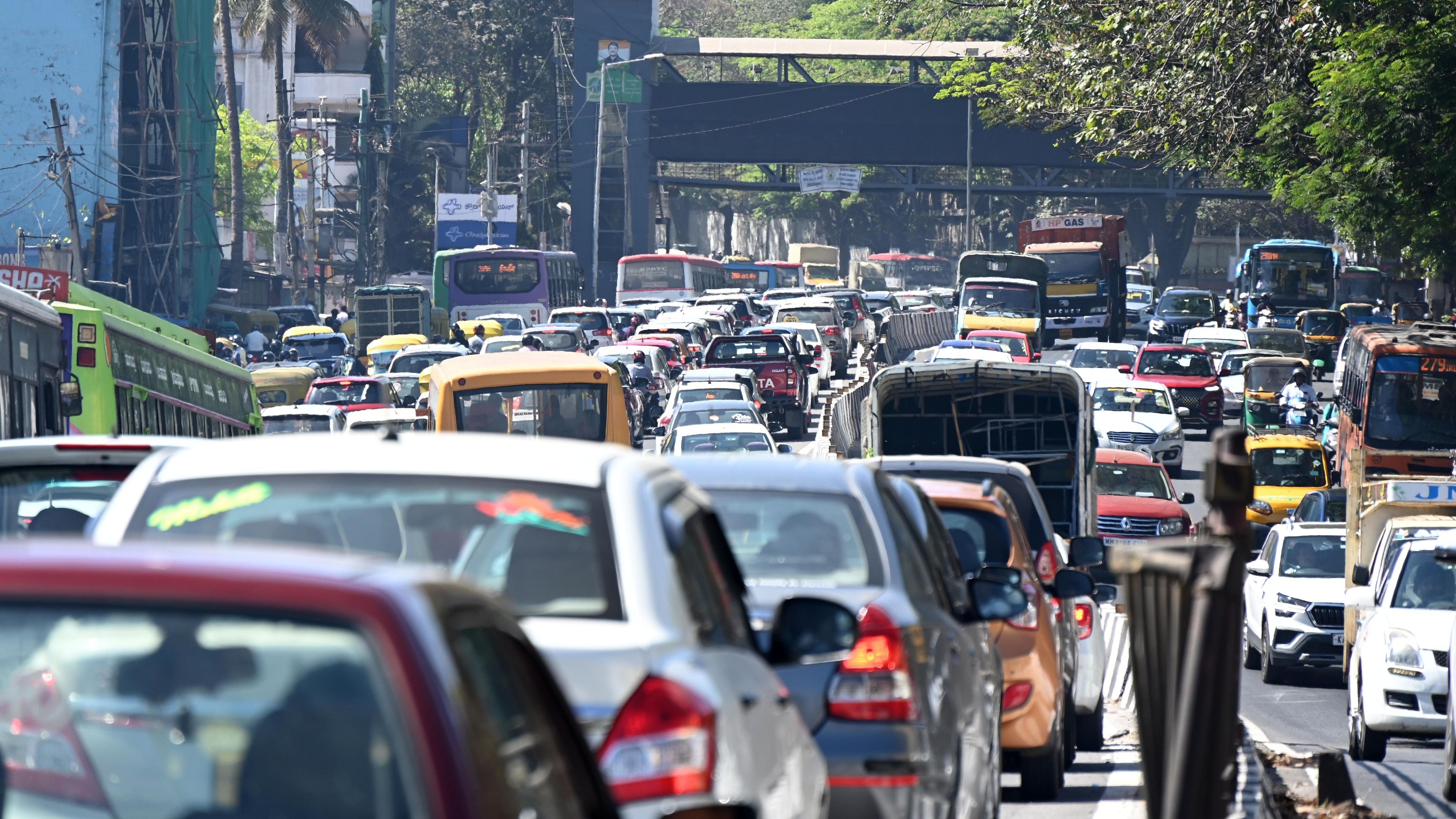
A file photo of heavy traffic jam on Airport road near Ganganagar during in Bengaluru
Credit: DH Photo
Bengaluru’s mobility has long been a thorny issue, with the city grappling with an increasing population and accompanying vehicular surge. In a recent report, Bengaluru ranked as the tenth most traffic-congested city globally, underscoring the severity of its mobility challenges. While traffic woes are a perennial discussion topic, solutions occasionally surface — many seemingly appearing out of nowhere. Examples include the forever embroiled Peripheral Ring Road (PRR), the contentious elevated corridors, and more recently, the tunnel roads.
Multiple state agencies seek to manage the traffic congestion primarily through enhancing and expanding metrorail, bus, and suburban rail services, network expansion, flyovers, and road widening. Despite these efforts, alleviating congestion remains elusive. The Directorate of Urban Land Transport, tasked with planning for city mobility, launched the Comprehensive Mobility Plan (CMP) in 2020. How “comprehensive” and “mobility-centric” the plan is is debatable. Notably, the plan uses “mobility” and “transportation” interchangeably, although they carry distinct meanings. While mobility encompasses access, safety, and affordability, transportation denotes the movement of people and vehicles. The CMP primarily focuses on transportation by fortifying road infrastructure to alleviate congestion stemming from private vehicle usage.
A good mobility plan connects citizens to work, schools, hospitals, entertainment, etc., as well as enhancing their ability to access these places. The CMP 2020, as part of its road network expansion strategy, proposes an array of projects, including the construction of a 78-kilometre PRR, 92 km of elevated corridors, 192 km of road widening, and parking infrastructure. These megaprojects focused on large-scale infrastructure and road development perhaps do not do justice to inclusive mobility. The idea that an increase in road capacity without a commensurate enhancement of public transport encourages the purchase of private vehicles is
well established.
More critically, in the current context, each of these proposals poses significant environmental ramifications. For instance, the proposed PRR project necessitates the acquisition of 800 acres of land, overseen by the Bangalore Development Authority (BDA). Environmental impact assessments indicate that approximately 1,036 hectares of land along a 73-km stretch will be acquired, resulting in the loss of 32,175 trees and the potential displacement of livelihoods due to the conversion of agricultural land into urban land. Farmers have time and again raised their voices against the acquisition of their land and their right to fair compensation.
Additionally, plans to construct flyovers above lakes like Jakarbande, Chikkabanahalli, and Thirumenahalli raise concerns about the ecological impacts of the proposed alignment.
Concern over the environmental implications of the proposed elevated corridors sparked considerable backlash from Bengaluru’s civic society, resulting in temporarily stalling the project. Whether elevated corridors or underground tunnels, these projects prioritise road infrastructure development disproportionately over public transport, undermining the principles of sustainable urban mobility. Reportedly, the proposal for 150 km of tunnel roads, costing approximately Rs 30,000 crore, is now at the detailed project report stage. Interestingly, the tunnel road project is not a part of the CMP, sparking debates about its alignment with the city’s long-term development goals.
The aim of the CMP is to integrate all public transport, paratransit, and associated infrastructure projects under a unified framework. Towards this end, in 2022, the legislative assembly passed the Bengaluru Metropolitan Land Transport Authority Bill, 2022, leading to the establishment of the Bengaluru Metropolitan Land Transport Authority (BMLTA). Positioned as a single planning agency for all transport initiatives within the Urban Mobility Region (UMR), the BMLTA was envisioned as a panacea for the city’s mobility problems.
Despite these institutional advancements, Bengaluru’s mobility landscape continues to grapple with problems of misaligned projects and siloed approaches. For instance, the BMRCL’s Hebbal-Sarjapur metro, which was proposed to be underground, clashes with the tunnel road proposed on the same road.
At the heart of the matter lies the question: how comprehensive is Bengaluru’s CMP 2020? These instances of discord prompt reflections on the efficacy and necessity of a central coordinating agency like the BMLTA, alongside pivotal planning documents such as the CMP 2020. The CMP cannot be “comprehensive” in isolation; the CMP and the RMP should be synchronised while integrating the transport-oriented development plans. While the uncertainty surrounding the timeline for Bengaluru’s master plan casts a shadow over this much-needed integration, the mandated ward planning serves as a good entry point in planning for and integrating land-use and transit requirements at the neighbourhood scale.
In conclusion, Bengaluru’s urban mobility saga encapsulates a multifaceted narrative characterised by ambitious projects, environmental concerns, institutional reforms, and socio-economic implications. Even as the city continues to grapple with its mobility conundrum, the recently launched Bengaluru Climate Action and Resilience Plan urges us
to ponder the climate sensitivity and viability of such investment-heavy
and infrastructure-heavy projects. A holistic approach balancing infrastructure development with environmental stewardship and social equity is an emerging imperative towards a sustainable and
inclusive urban future.
(The writers are practising urban and regional planners)